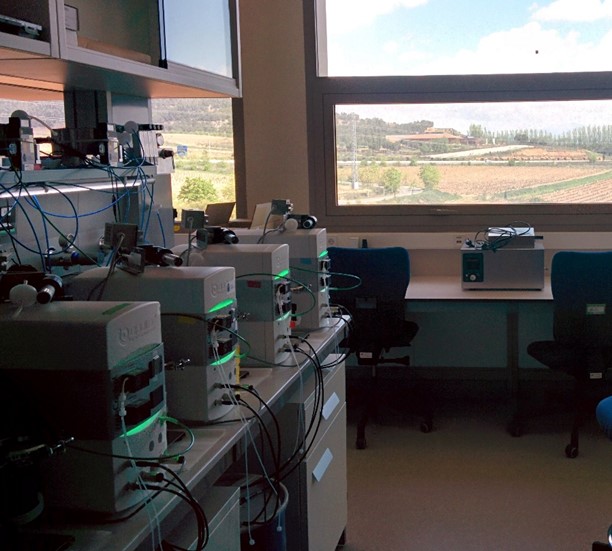
We are interested in the biology of yeasts, both of the genus Saccharomyces and alternative genera, paying attention to the most relevant aspects for their biotechnological use in oenology.
Most of the group's activity in recent years is grouped around two main lines of research. The first is the study of the interactions between different starter cultures (mainly between S. cerevisiae and non-Saccharomyces yeasts) during alcoholic fermentation. The other line of work deals with the development of systems to reduce the alcohol content of wines by using various tools derived from systems biology to reduce the alcohol yield of yeast metabolism.
In the first line we have been able to show some direct interactions between yeasts of different species, and we are also exploring, in a pioneering work, the involvement of extracellular vesicles produced by oenological yeasts and lactic acid bacteria in these interactions. In addition to bioreactor technology, and the purification of extracellular vesicle-enriched fractions, we make extensive use of transcriptomics and proteomics tools in this line. We have recently shown that extracellular vesicles from Metschnikowia pulcherrima are able to induce in S. cerevisiae a transcriptional response almost identical to that induced by living cells. For alcohol reduction, we explore both yeast respiratory metabolism and other alternatives, and both natural isolates and experimental evolution in the laboratory as a genetic improvement tool compatible with the immediate industrial application of the developed strains. We have developed several patents and contracts with companies in this line.
Also in collaboration with companies, we have developed new yeast strains that meet different oenological objectives. Random mutagenesis and experimental evolution are the two main tools we use in this line of work.
https://orcid.org/0000-0001-7388-1660
https://orcid.org/0000-0002-0130-6111
Mejias-Ortiz, M., Mencher, A., Morales, P., Tronchoni, J., Gonzalez, R. (2023) Saccharomyces cerevisiae responds similarly to co-culture or to a fraction enriched in Metschnikowia pulcherrima extracellular vesicles. Microb. Biotechnol. DOI: 10.1111/1751-7915.14240
Mencher, A., Mejias-Ortiz, M., Morales, P., Tronchoni, J., Gonzalez, R. (2022) Protein content of the Oenococcus oeni extracellular-vesicles enriched fraction. Food Microb. 106: 104038. DOI: 10.1016/j.fm.2022.104038
Tronchoni, J., Gonzalez, R., Guindal, A., Calleja, E., Morales, P. (2022) Exploring the suitability of Saccharomyces cerevisiae strains for winemaking under aerobic conditions. Food Microb. 101: 103893. DOI: 10.1016/j.fm.2021.103893
Gonzalez, R., Morales, P. (2022) Truth in wine yeast. Microb. Biotechnol. 15: 1339-1356. DOI:10.1111/1751-7915.13848
Mencher, A., Morales, P., Curiel, J. A., Gonzalez, R., Tronchoni, J. (2021) Metschnikowia pulcherrima represses aerobic respiration in Saccharomyces cerevisiae suggesting a direct response to co-cultivation. Food Microbiology, 94: 103670 DOI:10.1016/j.fm.2020.103670
Morales, P., Mencher, A., Tronchoni, J., Gonzalez, R. (2021) Extracellular vesicles in food biotechnology. Microb. Biotechnol. 14: 8-11 DOI:10.1111/1751-7915.13657
Mencher, A., Morales, P., Tronchoni, J., Gonzalez, R. (2021) Mechanisms involved in interspecific communication between wine yeasts. Foods 10: 1734. DOI:10.3390/foods10081734
Mencher, A., Morales, P., Valero, E., Tronchoni, J., Patil, K.R., Gonzalez, R. (2020) Proteomic characterization of extracellular vesicles produced by several wine yeast species. Microb. Biotechnol. 13: 1581-1596 DOI:10.1111/1751-7915.13614
Curiel, J.A., Morales, P., Gonzalez, R., Tronchoni, J. (2017) Different non-Saccharomyces yeast species stimulate nutrient consumption in S. cerevisiae mixed cultures. Front. Microbiol. 8: 2121 DOI: 10.3389/fmicb.2017.02121
Tronchoni, J., Curiel, J. A., Morales, P., Torres-Pérez, R., Gonzalez, R. (2017) Early transcriptional response to biotic stress in mixed starter fermentations involving Saccharomyces cerevisiae and Torulaspora delbrueckii. Int. J. Food Microbiol. 241: 60-68 DOI: 10.1016/j.ijfoodmicro.2016.10.017
